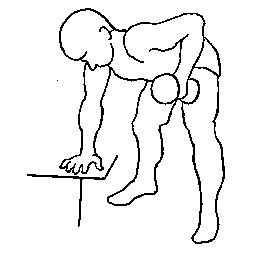|
Taking One-Arm Dumbell Rows To The MAX!
 The One-Arm Dumbell Row is one of the best lat-building exercises you can do. If you knew of a way to be able to not only perform it with heavier weight but in a far safer manner for your lower back, would you be interested?
The One-Arm Dumbell Row is one of the best lat-building exercises you can do. If you knew of a way to be able to not only perform it with heavier weight but in a far safer manner for your lower back, would you be interested?
I have just what you're looking for: a simple body-positioning trick that will INSTANTLY allow you to use much heavier weight with good form without compromising the health of your lower back.
The typical one-arm dumbell row is done on a bench with one knee placed on the end, one hand set forward on the bench to brace the upper body and the other foot planted solidly beside the bench. The lower back should be arched and tight and the head should be looking somewhat up and forward.
This position is absolutely fine for the back and body when you are in it without weight. Now let's add a dumbell and see what happens.
Generally, you are taught to hold the dumbell in your hand, let it stretch forward a little then bring it up along the outside of your thigh and up towards your hip. Nothing wrong with that, right?
Wrong! Bringing the dumbell up along the outside of your thigh can not only greatly limit the amount of weight you're able to use safely for this exercise, it can also compromise the safety of your lower back. The technique I'm about to show you will TOTALLY eliminate these problems, making the exercise safer and making your immediately stronger in it.
How can I go against the teachings of decades of exercise instruction? Easy, I do it every day. Quite often, it actually ends up being a lot better for you!
What's the technique? Instead of placing your foot beside the bench and bringing the dumbell up along the outside of your thigh, set your foot out wide to the side and bring the dumbell up along the INSIDE of your thigh (your knee should be slightly bent when you do this).
It doesn't sound earthshattering but you'll notice an IMMEDIATE difference in how the exercise feels. You will feel stronger and more stable right away.
When you examine the standard performance of this exercise, you'll see one glaring problem: the resistance is placed entirely OUTSIDE of your base of support during the movement. Your base of support is formed by your legs and your arm on the bench. When the resistance is outside of your base of support, i.e. the dumbell coming up the outside of your thigh, your body must attempt to counterbalance this torque with your lower back.
 When you're using lighter weights, it doesn't matter so much as the resistance is not enough to really cause problems. Imagine, however, trying to do a one-arm dumbell row with a dumbell that weighs almost as much as you do. Think you'll be able to hold that outside your thigh and not fall over or severely injure your back?
When you're using lighter weights, it doesn't matter so much as the resistance is not enough to really cause problems. Imagine, however, trying to do a one-arm dumbell row with a dumbell that weighs almost as much as you do. Think you'll be able to hold that outside your thigh and not fall over or severely injure your back?
By setting your foot out wide (like an angled brace holding up a retaining wall), you immediately widen your base of support, making yourself far more stable and increasing your power. Bringing the resistance up INSIDE of your base of support allows you to instantly use much heavier weight without the dangerous, unbalanced torque on your lower back and body.
Using this technique allowed me to perform 3 reps (with good form) with a home-made 210 pound dumbell. This dumbell weighed 20 pounds more than I did at the time.
When you try this technique and are able to starting moving heavier weights, be absolutely sure you keep a tight arch in your lower back. DO NOT allow it to round over at all. Rounding your lower back not only decreases the effect of the exercise on the lats, it also immediately relaxes the muscles of the spine that work to stabilize the spine. The result: possible immediate injury. Keep it arched and keep it tight.
Give this positioning technique a try in your next back workout. You will notice an immediate difference in how the exercise feels and realize an immediate increase in the amount of weight you are able to handle with it.

More Articles by Author Nick Nilsson
Return To Weight Lifting Articles Archive
|